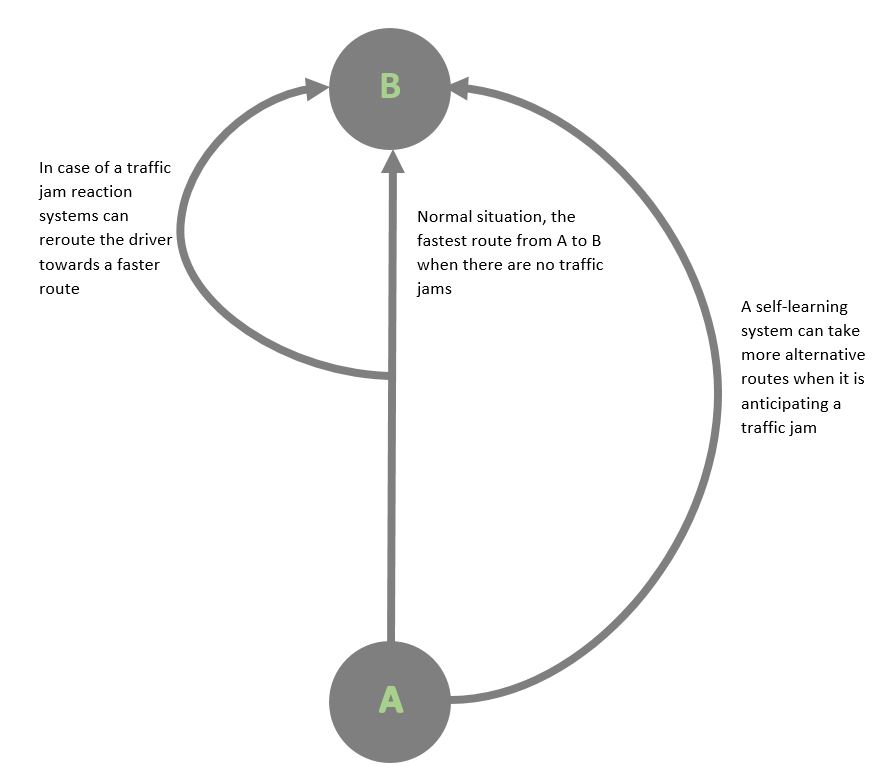PRE2016 3 Groep13: Difference between revisions
No edit summary |
|||
| Line 45: | Line 45: | ||
Furthermore our navigation idea will request people to drive different roads, which at points will probably make them lose time on their journey. When looking at literature we find something called: “risk aversion”[2][3]. Risk aversion is a human trait where someone would avoid taking a favorable bet (overall travel time decrease) when it means they can directly lose out (more travel time)[4]. | Furthermore our navigation idea will request people to drive different roads, which at points will probably make them lose time on their journey. When looking at literature we find something called: “risk aversion”[2][3]. Risk aversion is a human trait where someone would avoid taking a favorable bet (overall travel time decrease) when it means they can directly lose out (more travel time)[4]. | ||
== User research == | |||
== To be continued == | == To be continued == | ||
Revision as of 20:47, 3 March 2017
Introduction
This wiki page will display the possibilities of self learning navigational software. Throughout the report several points of attention will be introduced, investigated and processed in the prototype navigational system. The goal of the system is to create a cooperative/inter-vehicular, high-level (Think about; no traffic lights) and based on the current situation (hardly any self driving cars, not all people have navigational systems). This research is set up trying to answer the following research question:
How can the travel time be minizied while maximizing overall utility, looking at user and society, by using a self learning, inter-vehicular cooperative navigation system?
Objectives
Minimize travel time
The main goal of the system is to minimize travel time by rerouting users, to prevent longer waiting times caused by traffic jams.
Maximize overall utility
The utility can be split in three groups.
User
- Minimize travel time, this is the main objective as mentioned above.
- Estimate arrival time by predicting traffic jams so the user knows the optimal route and best moment of departure to reach the goal location on time.
- Making the system fair for all users. This will require user research in finding the fairest solution.
- Taking the privacy of the user into account by doing user research.
Society
- Traffic jam prevention to minimize unnecessary pollution, by rerouting to minimize unnecessary waiting time.
- Minimize disturbance by rerouting through less populated locations.
Enterprises
- Creating a system that is better than the present navigation systems, so potential users will be interested in buying this system.
State of the Art
There are a lot of different navigation devices available currently. The most simple one is only able to tell you the shortest route. A small upgrade also allows the user to exclude certain routes, like toll roads and tunnels. These often also give a choice for the user to either take a fastest (time) or shortest (distance) route. Some devices also allow traffic information incorporation which ask you to reroute if there is a traffic jam. When combining such a navigation system with a self driving car it is also possible to make the decision automatically. These all however respond to a situation instead trying to avoid certain situations.
Improvement over state of the art
To improve the state of the art it is important to know what the implications are of the current system. These systems will reroute users as soon as there is a faster route available and thus will distribute traffic equally over the roads available, which may seem like the optimal situation. A selflearning system however should have more roads available, since it can predict traffic jams that havent even happend yet. It can reroute the user many kilometers before the actual traffic jam and thus prevent new traffic jams in reroute roads.
Approach
The goal of the research is to improve the current traffic situation. This can only be considered an improvement when the changes do not diminish the overal utility. This means that within the navigation system the user aswell as the society have to play an important role. As the time window is quite a tight one this research will be conducted simultaniously. The group of researchers will be split where four members of the team will work on making the selflearning navigation work. The remaining two members will focus on the users and society. By frequent interaction, the team will be able to create a working navigational system in which the user and society will be strongly embedded. This also allows the prototype to be as representable as possible.
The completion of the program will also include a visual simulation which allows all team members as well as external personel to use and understand the way the system operates, and what conclusions it provides.
User and Society
People behave differently when wearing something to hide their identity[1]. This also happens in a car. People are not directly visible and thus act more selfish. As long as people are driving their car (instead of autonomous), we can investigate further if/how we want to incorporate this.
Furthermore our navigation idea will request people to drive different roads, which at points will probably make them lose time on their journey. When looking at literature we find something called: “risk aversion”[2][3]. Risk aversion is a human trait where someone would avoid taking a favorable bet (overall travel time decrease) when it means they can directly lose out (more travel time)[4].
User research
To be continued
References
[1]https://newrepublic.com/article/117152/how-sunglasses-and-masks-affect-moral-behavior
[2]http://www.jstor.org/stable/2937956?seq=1#page_scan_tab_contents
